Montana and Idaho are moving to host the first open gray wolf hunts in the lower 48 states after the animal's removal from the endangered list across much of the Northern Rockies.
Montana wildlife commissioners voted Wednesday to let hunters throughout the state shoot 75 wolves, or 15 percent of Montana's population, beginning in mid-September.
In Idaho, commissioners meet later this month to set their quota. A prior plan called for hunting almost 250 wolves.
Legal challenges to the hunts are certain as environmentalists argue wolves could again be driven toward extinction.
Experts, however, said wiping out wolves would be difficult. And state wildlife managers said the quotas are crucial to keep the fast-breeding predators in check and limit attacks on domestic sheep and calves.
"We're signaling our commitment to being responsible wildlife managers," said Montana's lead wolf biologist, Carolyn Sime.
Species had been wiped out in many areas
Without hunting or another means to manage wolves, she added, "you either eliminate all the wolves or you eliminate all the livestock."
Gray wolves once ranged from Alaska to Mexico. Hunting, trapping and government-sponsored poisoning wiped out the species across most of the lower 48 states by the 1930s.
Listed as endangered in 1974, wolves did not return to America's Northern Rockies in significant numbers until the mid-1990s, when 66 Canadian wolves were relocated to Idaho and Wyoming.
Last year, when the region's wolves were briefly pulled from the endangered species list, Wyoming let its residents kill a small number in a designated predator zone before the animals were reinstated to the list.
There are now an estimated 1,350 of the predators in Montana and Idaho. Three-hundred wolves in Wyoming remain under federal protection because of a state law there considered hostile to wolves.
Wyoming Attorney General Bruce Salzburg has challenged that status in federal court in Cheyenne. He argues the state is entitled to manage wolves and would ensure their conservation.
In Montana and Idaho, the removal of wolves from the endangered list in May resulted in two lawsuits by environmental and animal rights groups. The consolidated cases are pending before U.S. District Judge Donald Molloy in Missoula.
Doug Honnold, an attorney with Earthjustice, an environmental law firm handling the legal action, said he was waiting to learn what Idaho's quota will be before deciding on the next legal step.
"We don't think hunts should be allowed until there's legitimate recovery," he said.
Thousands of wolves in Alaska
Alaska has an estimated 10,000 wolves, the most in the country. The gray wolf has never been listed as endangered in that state and about 1,100 are trapped or hunted annually.
Alaska state officials say the predator's population remains healthy, despite criticisms over how wolves are killed in the state, including aerial gunning.
A study completed last year on wolves across North America showed up to 30 percent of a region's wolf population can die from human causes, including hunting, with no decrease in overall population growth.
"It's hard for people to grasp that you could go out there and shoot 30 percent of the wolves and still have a growing population," said lead author Layne Adams, a wolf researcher with the U.S. Geological Survey. "People don't tend to recognize how prolific wolves are."
Sime, Montana's lead wolf biologist, said deer and elk hunters who shoot a wolf opportunistically are expected to account for the bulk of this year's harvest in the state.
Wildlife officials hope to refine the state's hunting season in coming years to target those wolves most likely to kill livestock, she said.
